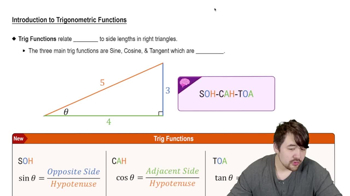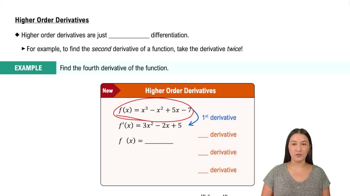Table of contents
- 0. Functions7h 52m
- Introduction to Functions16m
- Piecewise Functions10m
- Properties of Functions9m
- Common Functions1h 8m
- Transformations5m
- Combining Functions27m
- Exponent rules32m
- Exponential Functions28m
- Logarithmic Functions24m
- Properties of Logarithms34m
- Exponential & Logarithmic Equations35m
- Introduction to Trigonometric Functions38m
- Graphs of Trigonometric Functions44m
- Trigonometric Identities47m
- Inverse Trigonometric Functions48m
- 1. Limits and Continuity2h 2m
- 2. Intro to Derivatives1h 33m
- 3. Techniques of Differentiation3h 18m
- 4. Applications of Derivatives2h 38m
- 5. Graphical Applications of Derivatives6h 2m
- 6. Derivatives of Inverse, Exponential, & Logarithmic Functions2h 37m
- 7. Antiderivatives & Indefinite Integrals1h 26m
- 8. Definite Integrals4h 44m
- 9. Graphical Applications of Integrals2h 27m
- 10. Physics Applications of Integrals 2h 22m
3. Techniques of Differentiation
Higher Order Derivatives
Problem 3.5.65.b
Textbook Question
Explain why or why not Determine whether the following statements are true and give an explanation or counter example.
b. d²/dx² (sin x) = sin x.
 Verified step by step guidance
Verified step by step guidance1
To determine if the statement \( \frac{d^2}{dx^2} (\sin x) = \sin x \) is true, we need to find the second derivative of \( \sin x \).
First, find the first derivative of \( \sin x \). The derivative of \( \sin x \) with respect to \( x \) is \( \cos x \).
Next, find the second derivative by differentiating \( \cos x \). The derivative of \( \cos x \) with respect to \( x \) is \( -\sin x \).
Thus, the second derivative of \( \sin x \) is \( -\sin x \), not \( \sin x \).
Therefore, the statement \( \frac{d^2}{dx^2} (\sin x) = \sin x \) is false. The correct second derivative is \( -\sin x \).
 Verified video answer for a similar problem:
Verified video answer for a similar problem:This video solution was recommended by our tutors as helpful for the problem above
Video duration:
1mPlay a video:
Was this helpful?
Key Concepts
Here are the essential concepts you must grasp in order to answer the question correctly.
Second Derivative
The second derivative of a function measures the rate of change of the first derivative. It provides information about the concavity of the function and can indicate points of inflection. In this context, calculating the second derivative of sin x involves differentiating the function twice with respect to x.
Recommended video:

The Second Derivative Test: Finding Local Extrema
Trigonometric Functions
Trigonometric functions, such as sine and cosine, are periodic functions that relate angles to ratios of sides in right triangles. The sine function, sin x, oscillates between -1 and 1 and has a specific pattern of derivatives: the first derivative is cos x, and the second derivative is -sin x.
Recommended video:

Introduction to Trigonometric Functions
True/False Statements in Calculus
In calculus, determining the truth of a statement often involves verifying mathematical identities or properties. For the statement d²/dx² (sin x) = sin x, one must compute the second derivative and compare it to sin x to establish its validity, which in this case reveals that the statement is false.
Recommended video:

Fundamental Theorem of Calculus Part 2

 2:42m
2:42mWatch next
Master Higher Order Derivatives with a bite sized video explanation from Callie
Start learningRelated Videos
Related Practice




